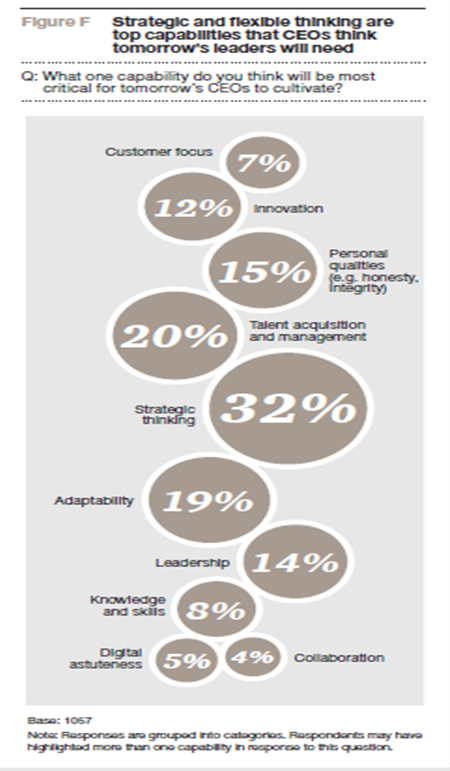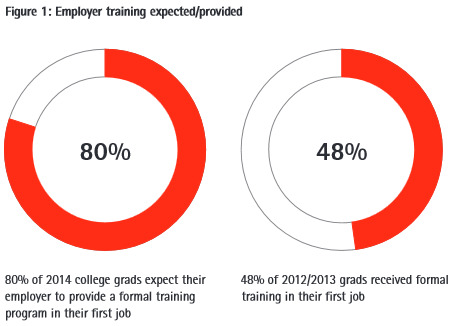 Here’s another survey analysis and report that should be required reading for all HR professionals: pwc’s 18th Annual Global CEO Survey. The survey looks at how business leaders are finding new ways to compete in “an era of unprecedented digital change.” I know, it sounds like another consulting firm’s move to make the complicated even more complicated and gin up their sales. But I didn’t find this analysis to be that. Instead, I found it useful to put context around some of our biggest challenges and opportunities. 1,322 CEOs in 77 countries were interviewed: 125 in Central and Eastern Europe; 459 in Asia Pacific, 94 in the Middle East and Africa; 330 in Western Europe; 167 in Latin America and 147 in North America. This was truly a global survey.
Here’s another survey analysis and report that should be required reading for all HR professionals: pwc’s 18th Annual Global CEO Survey. The survey looks at how business leaders are finding new ways to compete in “an era of unprecedented digital change.” I know, it sounds like another consulting firm’s move to make the complicated even more complicated and gin up their sales. But I didn’t find this analysis to be that. Instead, I found it useful to put context around some of our biggest challenges and opportunities. 1,322 CEOs in 77 countries were interviewed: 125 in Central and Eastern Europe; 459 in Asia Pacific, 94 in the Middle East and Africa; 330 in Western Europe; 167 in Latin America and 147 in North America. This was truly a global survey.
The survey findings are grouped into 5 themes:
- Growth
- Competition
- Technology
- Partnering
- Diversity
The first four themes are fairly predictable – and they all have some impact on talent strategies and HR functions – but the fifth, Diversity, might be a surprise to you. Think about it. More than 1,300 CEOs around the world were interviewed for this survey. Would you have predicted that Diversity was among the 5 most critical themes to emerge? You might have hoped for it, but would you have predicted it?
This survey analysis report is a roadmap for HR to anticipate what’s coming in terms of focus and strategy from the CEO. The report is not long. You could read it in an hour. And come away with some critical new business perspectives that will make your HR strategies and plans align with the real world – as your CEO sees it – and support your business’s growth plans.
I’ll share just two graphics that I found interesting. The first shows the range of risks that CEOs are beginning to be concerned about:
 CEOs were asked how concerned they were about a list of potential economic, policy, social and business threats to their organization’s growth prospects. You can see the list above. Do you see that the threat of not having access to necessary skills is a greater threat then cyber security? Than the speed of technological change? Than Geopolitical uncertainty? Do you see that of the list they could choose from, CEOs chose the threat of not having access to necessary skills as the second most concerning threat to their organization’s growth processes?
CEOs were asked how concerned they were about a list of potential economic, policy, social and business threats to their organization’s growth prospects. You can see the list above. Do you see that the threat of not having access to necessary skills is a greater threat then cyber security? Than the speed of technological change? Than Geopolitical uncertainty? Do you see that of the list they could choose from, CEOs chose the threat of not having access to necessary skills as the second most concerning threat to their organization’s growth processes?
That seems big to me. So, are your talent acquisition, development and retention strategies and programs developing fast enough to address this concern?
The second chart I will share shows just how all-pervasive and consistent the lack of talent concern is for CEOs:
 The question posed to these CEOs was “what one capability do you think will be most critical for tomorrow’s CEO’s to cultivate?” The choices were:
The question posed to these CEOs was “what one capability do you think will be most critical for tomorrow’s CEO’s to cultivate?” The choices were:
- Innovation
- Leadership
- Strategic Thinking
- Customer Focus
- Collaboration
- Digital Astuteness
- Personal Qualities (e.g. honesty, integrity)
- Adaptability
- Knowledge and Skills
- Talent Acquisition and Management
It wasn’t surprising to me that out of that list of 10 critical future CEO capabilities that Strategic Thinking would be first on the list of necessary capabilities. And it’s first by a mile. But look at what is in second place: Talent Acquisition and Management! I’ll bet you wouldn’t have predicted that.
This suggests to me that CEOs see lack of skills as such a big concern that they are going to involved personally with reducing that threat. Are you ready for your CEO to be actively involved in setting and executing your talent acquisition and development strategy? I’m not thinking that their involvement would be a bad thing. Quite the contrary. But I’m not sure the average HR department is ready to add their CEO to the team.
In my mind, these two graphs, and the subtext of the survey report, show that talent is becoming one of the most critical competitive advantages for business growth worldwide. And CEOs know it. The lack of talent/skills is clearly being evaluated by CEOs all over the world – in every sector and in every size of business – as their Achilles Heel. So CEOs get it. The big question is, does HR get it?
























